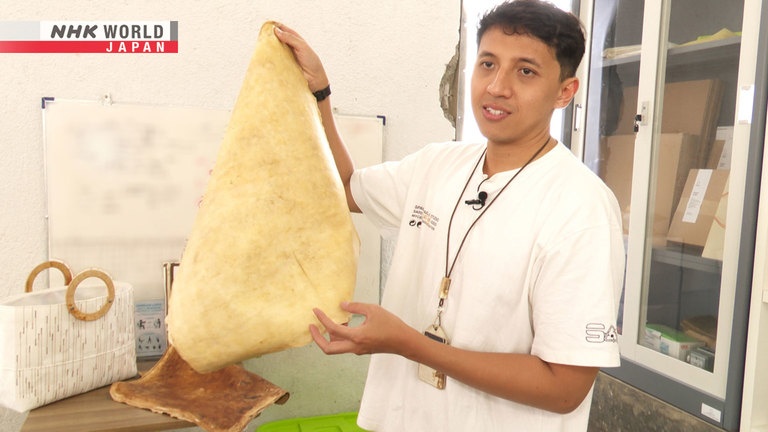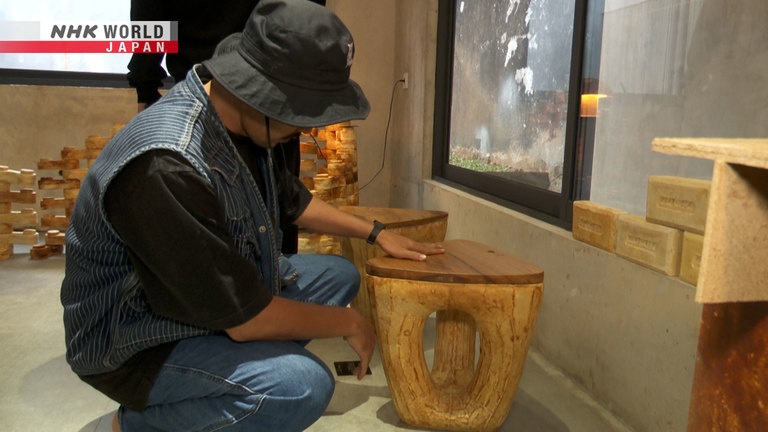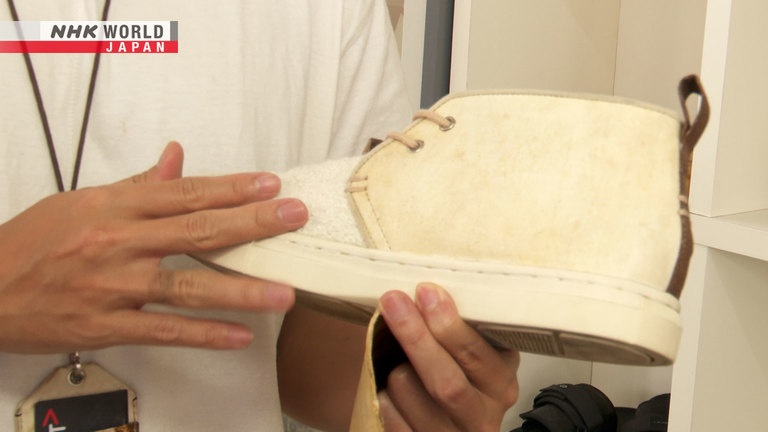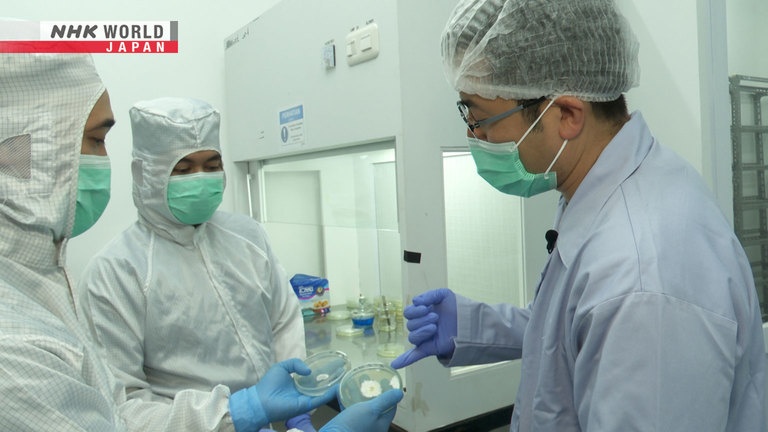Creating an Ethical Society with Mushrooms: Indonesia
Mycelium leather is a new material developed in Indonesia from mushrooms and agricultural waste. There is now an attempt to create an "ethical society" by mass-producing it using Japanese technology.




Transcript
This episode of Sharing the Future presents...
How did you find it?
- I was like looking around.
- Yeah.
...a project that opens up the way to the future with new technologies expanding the potential of mushrooms.
A mushroom is not just the part you
can see.
That is the final form trying to
reproduce in a flower-like state.
The greater part of a mushroom
is spread
inside the soil or trees as mycelium.
This is the mycelium of a particular kind of mushroom whose identity must remain confidential.
The technology that makes use of it is attracting attention as a way to help protect the global environment.
This is actually the Mylea that we just harvested.
It was made pure from mycelium which is the root part of mushroom, a strong fiber.
And we grow them by using agricultural waste after nutrients of the mushroom to grow.
This is mycelium leather, a natural man-made leather.
It's characterized by its low environmental impact compared to genuine leather,
as it requires a shorter production time and doesn't involve tanning.
Moreover, as a material, it features the same strength and flexibility as animal skins.
This new material is already being used for shoes and bags...
and applications are expanding.
It's even being considered for car seats.
This mycelium leather shocked me
at first sight.
Food was the only use for mushrooms
that I'd ever thought of.
As a mushroom dealer, I was very
interested
in offering mushrooms to all kinds of
industries.
Today, new initiatives for using this natural material are underway in Indonesia and Japan.
For us, ethical business is all about the holistic approach to its business.
It's all about not only looking for profit, while I don't care about the environment and the people.
And if we can create like the greater environmental impact,
we can actually make our business sustain longer.
Innovations developed in Indonesia and Japan's proud mushroom cultivation technology are changing the world.
Nagano Prefecture is a major producer of mushrooms in Japan,
boasting an annual production of 150,000 tons.
A Nagano-based trading company specializing in mushrooms is now teamed up with an Indonesian start-up company
to create a project to help realize an ethical society.
This room has just been renovated.
New tables and chairs will arrive at
the end of this month.
This will be a business meeting room.
Inui Keita is a core member of the project.
In 2022, his company purchased a long-abandoned inn, and it's currently being renovated.
They have various interesting ideas to play with.
In fact, it's well known that a samurai warrior's residence once stood here.
You can see Mt. Asama from here.
We're planning to convert this room
into an office
and rent it out to a local venture
company in the future.
As their office, Inui and his team are actually using this refurbished old storehouse,
which is detached from the main building.
Our office is very simple.
We do mainly marketing and
consulting, so we don't need
a lot of office furniture or fixtures.
In 2017, Inui set up a trading company specializing in mushrooms for overseas markets.
He is now actively promoting Japan's mushroom cultivation technology from Nagano to the rest of the world,
focusing on machines that improve production efficiency.
We publish a technical journal
about Japanese mushrooms.
It's all in English.
Mushroom cultivation is a niche field
so information isn't spread widely.
Utilizing our farmers' network,
we promote
Japanese mushroom cultivation
techniques overseas.
Through our activities, we hope
foreign countries
will find Japanese technology
excellent and want to introduce it.
Just before the Covid pandemic,
Inui and his colleagues contacted an Indonesian start-up company that possessed mycelium leather technology.
The move was triggered by company co-owner Obuchi Kota,
who was looking for new ways to boost the domestic mushroom industry.
As we did research on the Internet,
we found mycelium leather
especially innovative and intriguing.
Cisarua is a hilly area at an altitude of 1,000 meters located 150 kilometers from Jakarta, the capital of Indonesia.
In 2015, a start-up company was born in this farming village to develop a business using local materials.
Leading the product development is one of the co-owners, Ronaldiaz Hartantyo.
So, we started with agricultural waste.
This is sawdust or agricultural waste that we use.
And then after this, we put mushroom spores inside fungi spores.
It will harden like this. This is fully colonized.
As you can see here, the inside is actually similar like this.
Then after this, we can harvest the outer layer of the mycelium, into this.
We were privileged to observe part of the production process of mycelium leather.
We will take the outer surface of this mushroom block.
Mycelium leather is made by peeling the surface of blocks made from mushroom mycelium,
which is tightly bound to agricultural waste such as sawdust.
This is the harvest.
They like to say that rather than "manufacturing" mycelium leather,
they are "cultivating" it, so this process is always referred to as "harvesting."
During the six-week production period,
the product undergoes various other processes before completion including drying.
It's produced with an overwhelmingly lower environmental impact than genuine leather.
In addition, this block, called "the medium," which remains after the mycelium leather is harvested,
is processed and compressed for use as another material.
Our first operation of the materials is actually building materials.
So that's why our first operation is actually a similar like this.
A structural mushroom material which is hard but lightweight.
This chair produced in collaboration with an architectural company is 100% made of mushroom mycelium.
Weighing only 3 kilograms, it has the strength to withstand a weight of 600 kilograms.
It's a truly magic material.
Simply by changing the manufacturing method,
it can be turned into flexible leather or a robust construction material.
So how was such a new material utilizing mushroom mycelium born?
A clue can be found in an Indonesian traditional foodstuff.
Have you got any "tempeh?"
Indonesian traditional food similar with our materials.
It's spongy.
"Tempeh" is an Indonesian foodstuff made from fermented soybeans.
It's characterized by its block shape with interwoven layers of white mycelium and beans.
It has no odor and a light taste, and it's widely used as a cooking ingredient.
This is a similar concept that we use for the materials.
Beginning of everything!
Inui and his colleagues believe that mycelium leather, the new material created in Indonesia,
will help to save the Japanese mushroom industry.
I think the Japanese mushroom industry
is at a turning point.
Currently, some companies are pulling
out of the mushroom-related business.
But from our point of view, that would
be a real waste.
In the mycelium leather making process,
for 60% of the hardware side,
such as the factory,
regular mushroom cultivation facilities
can be used.
In fact, the number of mushroom producers in Japan has decreased by 70%
over the past 20 years due to price competition and a lack of successors.
Mycelium leather production could provide a great opportunity for the dwindling number of mushroom producers.
Producing mycelium for mycelium leather can be achieved by using growing racks not currently in use.
This can be a great benefit for mushroom producers.
I see so much potential.
Inevitably, there are times when
rooms can't be used for cultivation.
If we can use such facilities which are
not being used,
we would like to take on the challenge.
Meanwhile, an Indonesian start-up company is trying to help solve local social issues
by means of mycelium leather production.
The company started with five founding members, including Ronaldiaz, now has 60 staff members.
Local villagers are employed in the factory, and expectations are high
for more job creation in this region with few job opportunities.
Working hours are from 9 am to 5 pm for both the researchers and production staff.
In the company led by Ronaldiaz, nearly half of the employees are women.
Indonesian women are still often prevented from entering society,
especially in farming villages where old values remain strong.
Against that background, the company has created a place for women to work with this project.
Sorting blocks for the next process.
- What are you doing here?
- Sorting blocks for the next process.
This one has white mycelium all over,
so it's in usable condition.
Rina Karlina works as an operator for the production team.
Being able to work here is a blessing.
We're so grateful that we could build
a house of our own.
Completed three years ago, Rina's house is about a 10-minute walk from the office.
When we paid a visit, we immediately noticed an object bearing the name of the company.
I like it very much.
Using scrap wood from the factory, Rina made it with her carpenter husband,
who in fact built their house.
My husband says it's up to me whether
to work or not.
Rina is a mother of two, a 17-year-old son and a 9-year-old daughter.
She says they still keep her hands full.
I want to help my husband and increase
our income as much as possible.
Women's participation in society is one form of ethical behavior that aims for a sustainable working environment.
Ronaldiaz majored in architecture at university.
When carrying out preservation work on Indonesian traditional buildings as a class project,
he came to believe that stabilizing the livelihood of villagers was the first step toward proper preservation.
To launch a business that could take advantage of village resources and technology,
he focused on biomaterials, which were gaining worldwide attention.
That's how the production of materials utilizing agricultural waste began.
Ronaldiaz has tried many types of waste that might be suitable for mycelium leather.
Sawdust, rice hulls, corn shells,
banana stalks, sugarcane bagasse...
More than 30 items.
And he now uses oil palm trees that have been felled.
Because if we want to produce in large quantity, we need the consistent amount.
Indonesia is one of the world's leading producers of palm oil.
The disposal of old oil palm trees that have reached the end of their life
and the squeezed waste of fruit produced in great quantities by large-scale plants has become an issue.
This kind of waste that we use is actually, to farmers, they usually don't use it any more.
Like usually some of the agricultural waste they burn it and then turn into the biomass, and then for energy.
However, for this one, in the plantation,
usually they burn it in the open air and then the smoke goes to Singapore.
Ronaldiaz believed that the spread of their project could help to solve his country's environmental problems.
They were equipped with innovations that could impact the world and the raw materials needed.
What was needed next was the technology to enable mass production of the new materials.
It was at this point that Inui and his colleagues contacted them.
Adi Reza Nugroho, a co-founder of start-up, witnessed firsthand the Japanese cultivation techniques in Nagano.
I'm quite impressed how they grow, or cultivate the mushrooms.
They are using the technology, automation system, can help the production, skill, seamlessly.
So, it inspired me to do more collaborations with them
because we also want us to scale the production using the same equipment that they have.
As a result, a joint venture consisting of one Indonesian company
and three Japanese companies, was established in July 2022.
Their first task was to prepare to market mycelium leather in Japan.
The know-how on the production of mycelium leather was introduced to Japan from Indonesia.
Will it show up? It's pretty big.
60 cm x 60 cm.
This is the largest size we're planning
to sell right now!
This is mycelium leather made in Japan.
Inui says he wants people to enjoy the unusual patterns that appear on the surface.
It's a primordia formation,
the so-called "eye of the mushroom."
The unique patterns are in fact the sign of the mushroom trying to grow.
By changing environmental factors,
we can adjust the percentage
of these patterns.
Many companies send us inquiries.
As expected, many people think a lot
about sustainability.
Mycelium leather is drawing attention
as a truly new sustainable material.
World-class fashion brands are also now working on development,
and the mycelium leather market is expanding.
The joint venture is currently improving a Japan-based mass production system
ready for implementing full-scale sales in the Japanese market.
The building has changed a lot.
A mycelium leather production plant is now being constructed by repurposing a disused city facility.
The company says that once it is completed,
mass production will be possible to meet the anticipated future demand for mycelium leather.
Construction's proceeding on schedule.
Cultivators of the mycelium who participate in the joint venture
have high expectations for the capabilities of the new plant.
Not limiting ourselves to producing
mushrooms as food,
we want to try new developments
in areas with potential.
In any event, we want to show the world
what is good in Japan.
The joint venture is preparing to mass produce mycelium leather not only in Japan but also in Indonesia.
The cityscapes in South and
Southeast Asia are similar.
I visited here one year ago,
in September 2022.
During the last year, we've focused
on introducing
the technology Indonesia possesses.
As Japanese factories start operating,
the purpose of this visit is to find out
what direction Indonesia's
global strategy will take,
and to coordinate how
the Japanese side establishes
its domestic and global strategies.
Japanese technology has already been introduced in some of the Indonesian factories.
One of these is a clean room for the cultivation of mycelium,
essential for the production of mycelium leather.
We make mycelium ourselves.
Certain control is needed to avoid
the mycelium depleting.
A portion of the grown mycelium is cut off and grown further.
The key here is to avoid contaminating the room where the work is done with germs.
Thorough measures are taken to prevent any influx via clothing or the air conditioning.
A special filter's placed here
and the air is let in from here.
No air comes in directly from outside.
It all comes in through here.
Japanese know-how, including the pollution control measures essential for the stable production of mycelium leather,
is a foothold for increased production.
This is the same also in Japan facility part of the HP AC system.
Robbi Zidna Ilman is a chief operating officer of the manufacturing department.
Then, the result is very good.
Because, in first half, we get the contamination more than 50%.
Now, the end of this year, we can reduce the contamination below 30%.
Robbi is looking forward to further improvements in production efficiency by Japanese technology.
The next future.
We're expecting we can maintain the contamination lower than 10%.
I think now we already set up our plant in Japan, right?
So, it might be better before you start construction in your plant in the future,
you come to Japan to see how we built the inside.
That may be helpful for you.
After we did some trials with MYCL Japan and here in Indonesia,
now we've become more confident to scale the facility
so we plan to increase the capacity by using the automation system,
better clean room, using Japan standard.
The number of friends who support the mycelium leather project is increasing.
Aparna Bhatnagar Saxena is one of them.
She supports the social advancement of women living in farming villages
through the production and sale of traditional handicrafts.
She is working with Ronaldiaz and his team to develop products.
What I like about them is young entrepreneurs started by experimenting locally.
And the fact that you are using the waste to create something that is eco-friendly.
And I am an environmentalist, so for me, I love them.
Ronaldiaz and his staff are preparing for an event to be held in Jakarta.
What they have in their hands is a new material for structural use.
The theme is "Thinking about Nature."
So, this is material from nature, so we're showcasing the material.
I guess that's one thing for sure because this is another material, not many people knows about it.
That's why we need to raise awareness about this on the market and the designers as well.
They are also putting a great deal of effort into promoting the use of the new materials.
One week later, objects made by the team are put on display at the event.
Many people are very interested in the products of the team.
Visitors to the venue include Indonesian architects and people from the fashion industry.
I couldn't believe these were made
from mushrooms.
Concrete's used for these formworks,
but this is sturdy and very lightweight.
It's amazing to discover we can create
these new materials.
I'm a student of architecture.
Such a thin, hard material can be
created from mushrooms...
It's a revolution in the
construction industry.
At the venue, Ronaldiaz is being asked many questions.
MYCL's objective is actually to provide high-quality sustainable materials through by technology
by utilizing agricultural waste and collaborating with the local community for a better future generation.
And that's because we believe mushroom can save the world.
December, 2023.
In Nagano, the new factory that will serve as the production base for Japanese mycelium leather launches operations.
This is the entrance to the inside of
the new plant.
Mushroom cultivation technology cultivated over many years in Japan
and innovations born in Indonesia have joined hands to share the future,
and mass production of the new materials has begun.
The first harvest at the new factory is scheduled in one month.
Being mushroom dealers, we love
Nature.
We have a great desire to live with
Nature.
We like mountains and rivers.
Using mushroom cultivation techniques
we can produce mycelium leather.
It's a new material of truly natural
origin, so I want you to hold it
and feel even a little that you're living
in harmony with Nature.
I want to see that kind of society.
Because we are also part of Nature.
Working toward the realization of an ethical society,
their challenge with innovation continues.